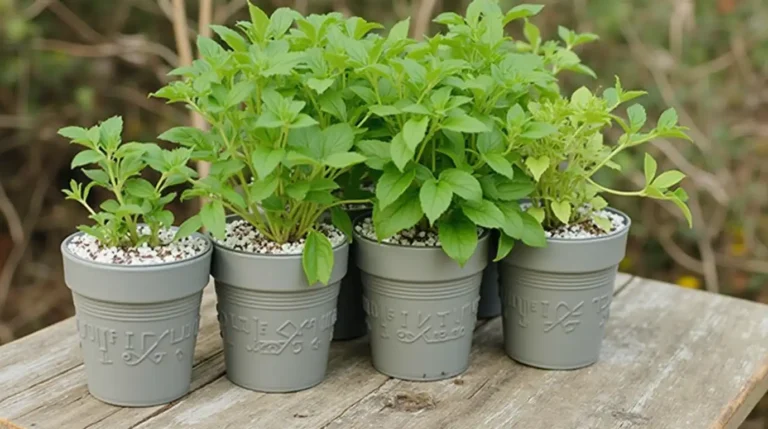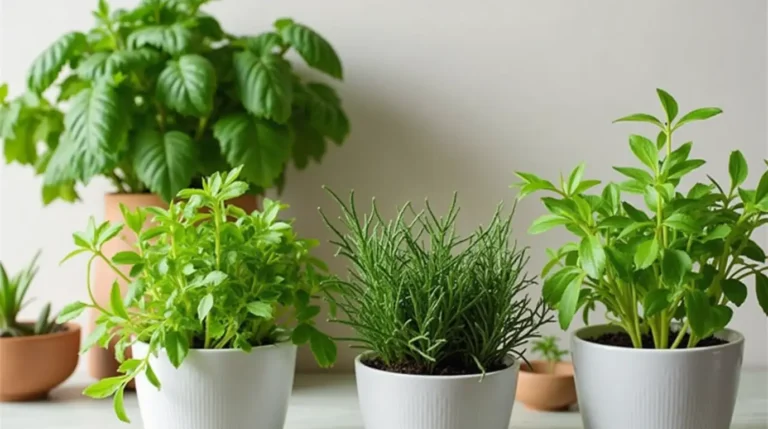The Pros and Cons of Different Herb Containers Plastic, Clay, Metal, and More
Introduction
Table of Contents
ToggleChoosing Herb Containers is essential for ensuring the health and growth of your herbs. The right container plays a significant role in moisture retention, space for growth, and providing a stable environment for herbs to thrive. When choosing herb containers, it’s important to consider the material, as each one—whether plastic, clay, metal, or wood—affects the herbs differently. Beyond aesthetics, choosing herb containers involves understanding how each material influences root development, temperature regulation, and overall plant health. Let’s dive deeper into how the right choice of herb container can make a big difference in your herb garden’s success.
Plastic Containers
Affordable and Versatile
When choosing herb containers, plastic pots are a popular option due to their affordability and versatility. Plastic containers are lightweight, easy to move, and come in a wide variety of shapes and sizes, making them an excellent choice for both indoor and outdoor herb gardens. Whether you’re choosing herb containers for a windowsill or a balcony, plastic is often the go-to material because it’s so easy to handle.
Pros and Cons of Choosing Plastic Herb Containers
Although choosing plastic herb containers can save you money, there are some considerations to be aware of. Plastic doesn’t provide as much breathability as other materials, which can lead to poor root development and even root rot if not properly drained. Additionally, plastic containers don’t regulate temperature very well, which could stress herbs during extreme heat or cold. However, they do retain moisture better than some materials, making them perfect for herbs like basil and mint that thrive in consistent moisture.
Plastic containers are ideal for herbs such as basil, mint, and parsley, which prefer moist, well-drained conditions.
Clay Pots
Classic and Natural Charm
Choosing clay pots for your herbs provides a natural, rustic look. Clay is a breathable material that allows moisture and air to pass through, helping your herbs’ roots grow healthily. When choosing herb containers for plants that prefer drier soil, like rosemary or thyme, clay is an excellent choice. The porous nature of clay allows for better water evaporation, preventing overwatering.
Why Choose Clay Herb Containers?
Although clay pots are heavy and can be expensive, they are highly effective for certain herbs. The challenge with choosing clay herb containers is that they can crack in freezing temperatures and may not be ideal for very cold climates unless brought indoors in winter. However, for gardeners in moderate climates, clay pots are one of the best materials to ensure healthy root development and moisture regulation.
Clay pots are perfect for herbs like thyme, oregano, and lavender, which require good drainage and air circulation.
Metal Containers
Industrial Edge with Durability
Choosing metal containers for your herb garden gives your space a sleek, modern look while providing a durable solution. Metal containers are sturdy and can withstand outdoor elements better than many other materials. Whether galvanized steel or aluminum, metal herb containers offer long-lasting protection for your plants.
The Pros and Cons of Metal Herb Containers
When choosing herb containers made from metal, there are a few important things to consider. While metal is durable, it can also heat up quickly, which can stress herbs that prefer cooler temperatures, like parsley and mint. The rapid temperature fluctuations can dry out the soil and harm your herbs. Another issue with metal containers is rusting, which can occur if they’re exposed to moisture over time. High-quality metal containers, however, can last for years with proper care.
Best herbs for metal containers include rosemary, chives, and thyme. These herbs are more heat-tolerant and can handle the temperature swings that metal pots create.
Ceramic Pots
Aesthetic and Temperature-Regulating
Choosing ceramic pots for your herb garden offers both beauty and functionality. Ceramic pots are not only visually appealing but also help maintain a stable temperature for your plants. They retain moisture effectively, making them ideal for herbs that need consistent moisture, such as basil and cilantro.
Benefits of Choosing Ceramic Herb Containers
While ceramic herb containers are heavy and can break easily, they are an excellent option for herbs that require steady moisture levels. The drawback of ceramic containers is their price and fragility, but if you’re looking for both aesthetics and functionality, ceramic pots are a fantastic choice. They offer excellent temperature regulation, keeping your herbs comfortable even in fluctuating weather conditions.
Herbs that thrive in ceramic pots include basil, parsley, and cilantro, which benefit from the moisture-retaining properties of ceramic material.
Wooden Planters
Eco-Friendly and Rustic
Choosing wooden herb containers offers an eco-friendly option for gardeners who want to create a rustic, natural look. Wood helps regulate temperature and retains moisture, creating the perfect environment for herbs. Additionally, wooden containers are often biodegradable and made from reclaimed materials, making them an environmentally conscious choice.
Why Choose Wooden Herb Containers?
Wooden containers do require regular maintenance to avoid rot, especially in outdoor environments. They’re heavier than plastic and may be more expensive, but they provide great insulation and moisture retention. If you’re choosing herb containers made from wood, ensure they’re treated to withstand the elements and ensure proper drainage to prevent waterlogging.
Wooden planters are great for herbs like sage, thyme, and oregano, which thrive in moisture-retentive environments with temperature regulation.
Self-Watering Containers
Low-Maintenance and Efficient
Choosing self-watering containers makes herb gardening much easier, especially for those with limited time. These containers allow your herbs to absorb the water they need, reducing the need for constant attention. For gardeners who are constantly on the go or beginners who are just learning, self-watering containers are an excellent choice.
Pros of Choosing Self-Watering Herb Containers
Self-watering herb containers help maintain consistent moisture levels, making them perfect for herbs like basil and cilantro that require frequent watering. However, these containers can be more expensive and may not come in as many design options as traditional pots. Additionally, if used improperly, self-watering containers can cause overwatering, leading to root rot.
Self-watering containers are ideal for herbs like mint, chives, and basil, which benefit from a consistent supply of water.
Hanging Baskets
Saving Space with Vertical Gardening
Choosing hanging baskets for your herb garden is a great way to save space while still growing a variety of herbs. By utilizing vertical space, hanging baskets allow you to create a lush herb garden without taking up precious floor space. These containers are perfect for small balconies, patios, or indoor areas with limited room.
Why Choose Hanging Herb Containers?
When choosing hanging herb containers, it’s important to ensure they are positioned well for sunlight and easy watering. Hanging baskets are great for trailing herbs like mint, thyme, and oregano, but can be difficult to water if placed too high or in hard-to-reach areas. Additionally, some herbs may grow too heavy for the basket to support, so it’s essential to monitor the weight distribution.
Hanging baskets are ideal for herbs like mint, thyme, and oregano that thrive in an airy, spacious environment.
Repurposed Containers
Eco-Friendly and Budget-Friendly Creativity
Choosing repurposed containers for your herb garden is a creative and eco-friendly way to garden on a budget. You can use items like mason jars, tin cans, old crates, and even shoes as herb containers. Repurposed herb containers are a unique way to recycle and add personal flair to your garden.
Advantages of Choosing Repurposed Herb Containers
When choosing herb containers from repurposed items, make sure they have proper drainage. Without drainage holes, containers like mason jars or cans can cause waterlogging and root rot. Ensure that your repurposed containers allow water to escape to keep your herbs healthy.
Repurposed containers are great for small herbs like basil, cilantro, and parsley, which don’t need extensive root space.
Choosing the Right Container for Different Climate Conditions
When choosing herb containers, the climate plays a significant role in your decision. In colder climates, materials like ceramic or wood help insulate your herbs, protecting them from the cold. In hot climates, moisture-retaining materials like plastic or ceramic are ideal for preventing your herbs from drying out too quickly.
Considerations for Drainage in Different Climates
Proper drainage is key, especially in wetter climates. If you live in an area with frequent rainfall, containers with excellent drainage, such as clay or wood, will prevent waterlogging. Temperature regulation and insulation are also essential in extreme climates, so choose containers that help regulate moisture and temperature effectively.
Final Thoughts on Selecting Herb Containers
When choosing herb containers, it’s important to consider the specific needs of your herbs, your space, and your climate. Each container material offers distinct advantages, and selecting the right one will ensure your herbs thrive. Whether you mix and match materials or stick with a single type, the right container can make all the difference in your herb garden’s success.
For more tips on Containers for Growing Herbs, visit this link




